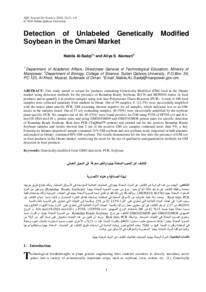Document
Detection of unlabeled genetically modified soybean in the Omani market.
Identifier
https://doi.org/10.24200/squjs.vol21iss1pp1-6
Source
Sultan Qaboos University Journal for Science. v. 21, no. 1, p. 1-6.
Contributors
Al-Ansariyah, Aliya S., Author
Other titles
الكشف عن الصويا المعدلة جينيا والغير معرفة في السوق العماني.
Country
Oman.
City
Muscat.
Publisher
College of Science, Sultan Qaboos University.
Gregorian
2016-11-01
Language
English
Subject
English abstract
This study aimed to screen for products containing Genetically Modified (GM) food in the Omani market using detection methods for the presence of Roundup Ready Soybean, Bt176 and MON810 maize in food products and to quantify it in positive samples using real time Polymerase Chain Reaction (PCR). A total of 100 food samples were collected randomly from markets in Oman. Out of 59 samples, 8 (13.5%) were successfully amplified with the maize plant specific PCR. GM screening showed negative for all samples, which indicated low or no GM maize in the samples tested. Out of 57 soy containing samples, 40 (70%) were successfully amplified by the soybean plant specific PCR. Six samples out of the 40 (15%) were found positive for GM using P35S-cf3/P35S-cr4 and HA-nos118-f/HA-nos118-r, primer pairs and using GMO5/GMO9 and GMO7/GMO8 primer pairs for specific detection of Roundup Ready Soybean. Real time PCR (TaqMan™ system) was carried out for the positive Roundup Ready Soybean samples and results showed that 2 out of the positive GM soy samples contained more than 5%; a Soy Formula for Infants (imported) sample contained 21% GM soybean and raw soybean seeds (imported in bulk amounts and packed in Oman) contained 88% GM soybean. The results demonstrate for the first time the presence of GM-soy in food products in the Omani market, reinforcing the need for the use of qualitative and quantitative methods for GM detection in food products.
ISSN
2414-536 X
Arabic abstract
هدفت هذه الدراسة إلى فحص المنتجات التي تحتوي على أغذية معدلة وراثيًا في السوق العمانية باستخدام طرق الكشف عن وجود فول الصويا المُعدّل وراثيًا (Roundup Ready)، وBt176، وذرة MON810 في المنتجات الغذائية، وتحديد كميتها في عينات إيجابية باستخدام تفاعل البوليميراز المتسلسل اللحظي (PCR). جُمعت 100 عينة غذائية عشوائيًا من أسواق عُمان. من أصل 59 عينة، تم تضخيم 8 عينات (13.5%) بنجاح باستخدام تفاعل البوليميراز المتسلسل الخاص بنبات الذرة. أظهرت نتائج فحص الكائنات المعدلة وراثيًا سلبية لجميع العينات، مما يشير إلى انخفاض أو انعدام الذرة المعدلة وراثيًا في العينات المختبرة. من أصل 57 عينة تحتوي على فول الصويا، تم تضخيم 40 عينة (70%) بنجاح باستخدام تفاعل البوليميراز المتسلسل الخاص بنبات فول الصويا. أظهرت ست عينات من أصل 40 عينة (15%) نتائج إيجابية لفحص فول الصويا المعدل وراثيًا باستخدام أزواج البادئات P35S-cf3/P35S-cr4 وHA-nos118-f/HA-nos118-r، بالإضافة إلى أزواج البادئات GMO5/GMO9 وGMO7/GMO8 للكشف الدقيق عن فول الصويا المُعدَّل وراثيًا. أُجري تفاعل البوليميراز المتسلسل اللحظي (PCR) باستخدام نظام TaqMan™ لعينات فول الصويا المُعدَّل وراثيًا الإيجابية، وأظهرت النتائج أن عيّنتين من عينات فول الصويا المُعدَّل وراثيًا الإيجابية تحتويان على أكثر من 5%؛ بينما احتوت عينة من حليب الصويا المُخصَّص للأطفال الرضع (مستوردة) على 21% من فول الصويا المُعدَّل وراثيًا، بينما احتوت بذور فول الصويا الخام (المستوردة بكميات كبيرة والمعبأة في عُمان) على 88% من فول الصويا المُعدَّل وراثيًا. وتثبت النتائج لأول مرة وجود فول الصويا المعدل وراثيا في المنتجات الغذائية في السوق العمانية، مما يعزز الحاجة إلى استخدام الأساليب النوعية والكمية للكشف عن الكائنات المعدلة وراثيا في المنتجات الغذائية.
Category
Journal articles

